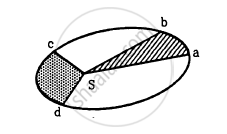Advertisements
Advertisements
प्रश्न
Let us assume that our galaxy consists of 2.5 × 1011 stars each of one solar mass. How long will a star at a distance of 50,000 ly from the galactic centre take to complete one revolution? Take the diameter of the Milky Way to be 105 ly
उत्तर १
Mass of our galaxy Milky Way, M = 2.5 × 1011 solar mass
Solar mass = Mass of Sun = 2.0 × 1036 kg
Mass of our galaxy, M = 2.5 × 1011 × 2 × 1036 = 5 ×1041 kg
Diameter of Milky Way, d = 105 ly
Radius of Milky Way, r = 5 × 104 ly
1 ly = 9.46 × 1015 m
∴r = 5 × 104 × 9.46 × 1015
= 4.73 ×1020 m
Since a star revolves around the galactic centre of the Milky Way, its time period is given by the relation:
`T = ((4pi^2r^3)/(GM))^(1/2)`
= `((4xx(3.14)^2xx (4.73)^2 xx 10^(60))/(6.67xx10^(-11)xx5xx10^(41)))^(1/2) = ((39.48xx105.82xx10^(30))/33.35)^"1/2"`
= `(125.27 xx 10^(30))^(1/2) = 1.12 xx 10^(16) s`
1 year = `365 xx 324 xx 60 xx 60 s`
1s = `1/(365xx24xx60xx60)` year
`:.1.12xx10^(16) s = (1.12 xx 10^(16))/(365xx24xx60xx60)`
= `3.55 xx 10^8` year
उत्तर २
Here, r = 50000 ly = 50000 x 9.46 x 1015 m = 4.73 x 1020 m
M = 2.5 x 1011 solar mass = 2.5 x 1011 x (2 x 1030) kg = 5.0 x 1041kg
We know that
`M =(4pi^2r^3)/(GT^2)`
or` T = ((4pi^2r^3)/"GM")^(1/2) = [(4xx(22/7)^2xx(4.73xx10^(20))^3)/(6.67xx10^(-11)xx(5.0xx10^(41)))]^(1/2)`
= `1.12 xx 10^(16)` s
APPEARS IN
संबंधित प्रश्न
State Kepler's law of orbit and law of equal areas.
A Saturn year is 29.5 times the earth year. How far is the Saturn from the sun if the earth is 1.50 ×108 km away from the sun?
Let the period of revolution of a planet at a distance R from a star be T. Prove that if it was at a distance of 2R from the star, its period of revolution will be \[\sqrt{8}\] T.
In the Following figure shows the elliptical path of a planet about the sun. The two shaded parts have equal area. If t1 and t2 be the time taken by the planet to go from a to b and from c to d respectively,

Observe the given figure showing the orbit of a planet moving around the Sun and write the three laws related to it:

The orbit of a planet moving around the Sun
In our solar system, the inter-planetary region has chunks of matter (much smaller in size compared to planets) called asteroids. They ______.
If the sun and the planets carried huge amounts of opposite charges ______.
- all three of Kepler’s laws would still be valid.
- only the third law will be valid.
- the second law will not change.
- the first law will still be valid.
A star like the sun has several bodies moving around it at different distances. Consider that all of them are moving in circular orbits. Let r be the distance of the body from the centre of the star and let its linear velocity be v, angular velocity ω, kinetic energy K, gravitational potential energy U, total energy E and angular momentum l. As the radius r of the orbit increases, determine which of the above quantities increase and which ones decrease.
Earth’s orbit is an ellipse with eccentricity 0.0167. Thus, earth’s distance from the sun and speed as it moves around the sun varies from day to day. This means that the length of the solar day is not constant through the year. Assume that earth’s spin axis is normal to its orbital plane and find out the length of the shortest and the longest day. A day should be taken from noon to noon. Does this explain variation of length of the day during the year?
Two planets A and B of equal mass are having their period of revolutions TA and TB such that TA = 2TB. These planets are revolving in the circular orbits of radii rA and rB respectively. Which out of the following would be the correct relationship of their orbits?
